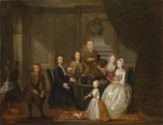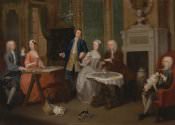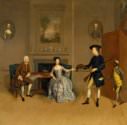Elihu Yale with Members of his Family and an Enslaved Child
[Unknown artist], Elihu Yale, the second Duke of Devonshire (YCBA)Elihu Yale, the second Duke of Devonshire, Lord James Cavendish, Mr. Tunstal, and a Page (Yale Center for British Art, Gift of Andrew Cavendish, eleventh Duke of Devonshire)

Unknown artist], Elihu Yale seated at table with the Second Duke of Devonshire and Lord James Cavendish, c. 1708, oil on copper[Unknown artist], Elihu Yale seated at table with the Second Duke of Devonshire and Lord James Cavendish, c. 1708, oil on copper. Yale University Art Gallery, Transfer from the Yale University Library, Gift of Mrs. Arthur W. Butler, 1960.51.
Elihu Yale with Members of his Family and an Enslaved Child
ca. 1719
John Verelst
Oil on canvas
79 1/4 × 92 3/4 inches (201.3 × 235.6 cm)
Nothing is known is about the boy on the right, who has just finished pouring Madeira (a sweet, fortified wine) into the glasses on the table. His fine red and grey livery (or uniform) identifies him as a servant, and the silver collar and padlock around his neck indicate that he is enslaved. At the table sit Elihu Yale (center), William Cavendish, second
Duke of Devonshire (right), and his younger brother James Cavendish (left). Near them is a man, who is identified on the back of the canvas as a lawyer named Mr. Tunstal. The portrait, which seems to be set on the Duke’s estate, Chatsworth, is believed to commemorate the signing of a marriage contract between Yale’s daughter, Anne, and James Cavendish. (The children and dancing master in the background may have been added later to represent their family.) This union between a nobleman and a merchant’s
daughter was brokered by the immense fortune that Yale amassed during his time in India with the East India Company—a fortune symbolized here by his diamond ring. Yale’s prominent position in the composition suggests that he commissioned the painting.
While archival sources reveal a great deal about Yale, the second Duke, and his brother, they tell us little about the young boy who serves them. We can fairly assume that he came to England on a slave ship. His proximity to the Duke suggests that he is a member of the Devonshire household. This cannot be confirmed, however, because servants’ registers from this period do not survive in the Chatsworth archive and records of Devonshire livery do not describe its appearance. Alternatively, it is possible that the boy
is present here as Yale’s servant. There is no direct evidence that Yale personally owned slaves, though another portrait, now in the collection of the Yale University Art Gallery, shows him with an enslaved servant. From 1687 to 1699, Yale served as governor of the East India Company’s settlement at Fort St. George, Madras (now Chennai). During that time, he oversaw the company’s slave trading activities, records of which survive in archives in Chennai.
In the absence of documentary evidence about him, we need to find other ways to imagine this boy’s history—a history which, much like Elihu Yale’s own, was shaped by Britain’s imperial expansion and the transatlantic slave trade. Although he has not traditionally been understood as one of the painting’s sitters, this exhibition
asks us to consider him as such.
B1970.1
Label on verso, center left: "Artist British School | Elihu Yale, the 2nd Duke of Devonshire, Lord | James Cavendish, Mr. Tunstal, and a Page. | Medium c. 1708 oil on canvas | Size 79 1/4 x 92 3/4 Accession no B1970.1 | Credit line Gift of the 11th Duke of Devonshire"; center left: "IR 30 | B1970.1"
Yale Center for British Art, Gift of Andrew Cavendish, eleventh Duke of Devonshire
![[Unknown artist], *Elihu Yale seated at table with the Second Duke of Devonshire and Lord James Cavendish*, c. 1708, oil on copper. Yale University Art Gallery, Transfer from the Yale University Library, Gift of Mrs. Arthur W. Butler, 1960.51. Unknown artist], *Elihu Yale seated at table with the Second Duke of Devonshire and Lord James Cavendish*, c. 1708, oil on copper](https://interactive.britishart.yale.edu/sites/default/files/styles/ycba_thumbnail/public/Elihu%20Yale%20%28YUAG%29.jpg?itok=w03U8fDN)





